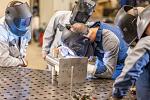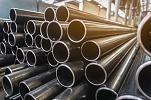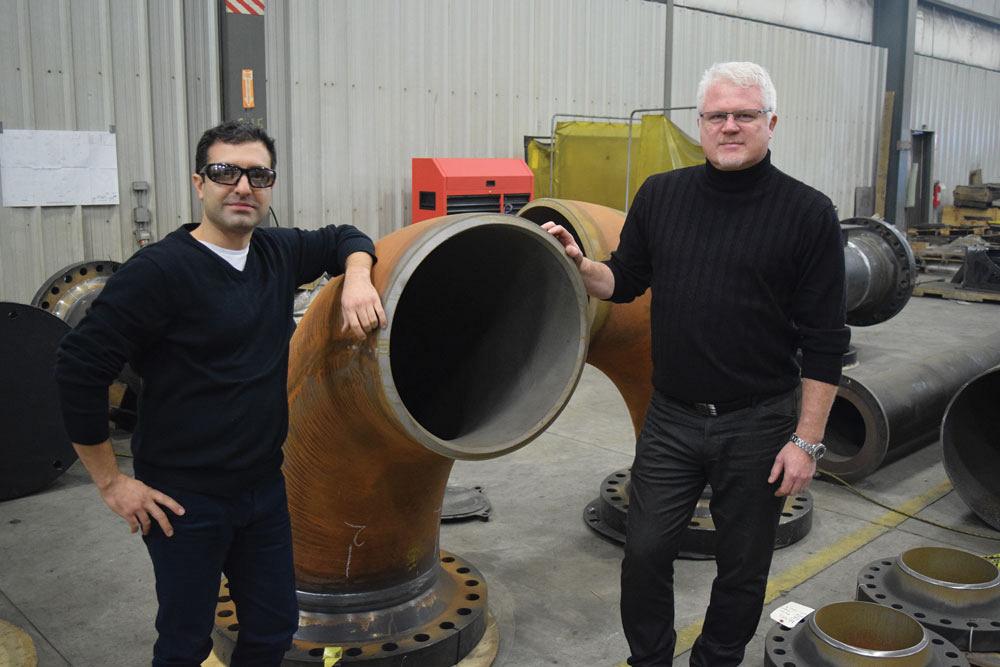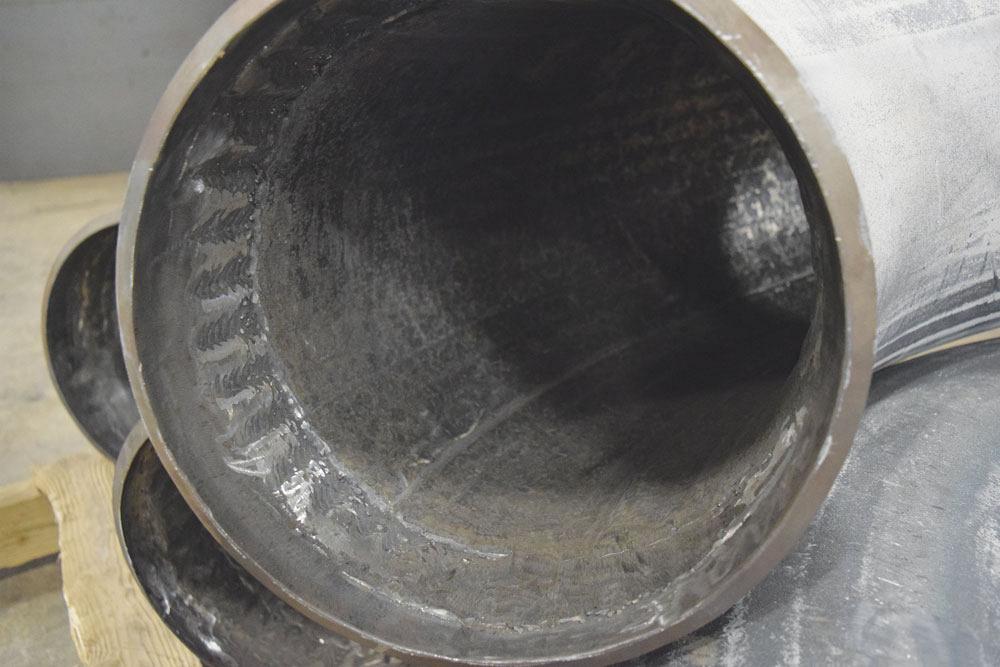Editor
- FMA
- The Fabricator
- FABTECH
- Canadian Metalworking
Cladding reimagined at JEBCO
Well-established Barrie, Ont., fab shop opens up new opportunities with a cladding system that offers a more consistent overlay in less time, using less material
- By Rob Colman
- February 14, 2017
- Article
- Fabricating
JEBCO Industries is a Barrie, Ont.-based fabrication shop that serves the needs of the mining, oil and gas, petrochemical, and water treatment industries. Its work on process equipment encompasses design, fabrication, coatings and linings, installation, commissioning, and repair.
The area where the shop is truly making a unique impact today, however, is in weld overlay services. Using available technology and the skills of its team, JEBCO has created its own cladding process that, according to the company, creates a better, more consistent finished overlay while using less material and taking less time.
HistoryJEBCO was founded in 1979 by Ernie Murray on the family’s farm in Innisfil, Ont. When Ernie had a serious accident that kept him in a wheelchair for a year in 1984, son Brett came onboard to support the business. In the fall of that year, Brett started welding seat belt parts for American Motors. Over the years the company’s clientele remained varied, from Kneel Easy garden work stools to tanks for mining companies. By 1998 the team was doing a substantial amount of work for the likes of Dorr-Oliver Eimco, a company known in the mining industry for more than a century.
JEBCO now has 150,000 sq. ft. of manufacturing space among all its facilities and employs 81 people. It processes over 6.5 million pounds of steel per year, sprays over 30,000 gallons of coatings per year, and accounts for over 80,000 hours of fabricating a year among its staff.
The shop in Barrie is equipped to handle plasma cutting, rolling, drilling, forming, machining, fitting, and welding of both thick and thin plate. It works in carbon steel, stainless steel, and aluminum. In addition to its broad connections in the resource industries, the company recently got final approval to become a Controlled Goods Program supplier to the Department of National Defence.
But Brett Murray understands that all of the standard fab work his shop can do isn’t necessarily going to draw unique and sustainable business to his door, particularly in the resource markets in which the company tends to shine.
Automation ShiftIn the mid-2000s, when Murray took on the role of president and CEO, there was a big push to send a lot of manufacturing to Mexico and to jettison small-part production to Asia. He knew JEBCO would have to adapt to manage this shift.
“We spent a lot of time in Mexico trying to figure out how we could work there,” Murray recalled. “We even looked at putting a plant there. But we decided instead that automation is the route we needed to follow. We need to automate what can’t be automated.”
JEBCO has always modeled its shop floor along the lines of an automotive production line; that is, rather than a worker going to the project, the project comes to the worker. Thus, the first bay of its 100,000-sq.-ft. facility is for primary processing of metals; the second bay is dedicated to processing and small fabrication; the third bay is where large fabrication jobs are undertaken; the fourth bay is where specialized stainless steel and aluminum fabrication takes place and final assembly is managed. Other bays account for machining and special-product development.
“We have all the same issues as any other company – issues of people, planning, and project management – but we look at our processes and our production in a way that we are trying to be globally competitive, not just regionally competitive,” Murray said.
Cladding OpportunitiesThe idea of tackling the cladding process came about via a client in 2012.
“We were doing a lot of work in the oilsands at the time. We saw that there was a market for cladding services, and we thought that there must be a better way to do it,” recalled Murray. “A client we were doing work for encouraged us to bid on a multi-million-dollar project, and we jumped at it with only a notion of what we eventually wanted to achieve.”
At that point it was a matter of finding the right people to realize Brett and Ernie Murray’s visions of the ideal cladding process. They ended up sourcing people from around the world, including Amir Baghaki, their automation manager.
“We were very lucky to find Amir; he is a phenomenal individual,” said Murray.
The JEBCO team first required a welding power source for their cladding concept. They chose to work with Fronius. Murray saw the value of the company’s Cold Metal Transfer (CMT) process for this type of work – the filler wire is retracted after every cycle, which allows the process to maintain a low heat input. This is perfect for cladding, in which the less potential for distortion of the base material, the better. In every cladding operation, dilution takes place with the base metal; however, the lower the thermal input and the penetration, the less dilution there is with the base metal, resulting in a cleaner overlay.
But Murray became enamoured of the technology for another reason: its ability to speak to other programs.
“It had coding abilities that we could marry up with a PLC so that they could talk to one another,” recalled Murray. “That was completely out of my thought process at the time.”
“These machines are really capable and flexible,” Baghaki explained. “They give you multiple options to do the job and many detailed parameters to change and optimize your process. These machines have an advanced communication module, and it gives you lots of data to control, react to, and optimize all the parameters.
“We designed and made our own programmable machine to control all the cladding head movements precisely, so during the process, our machine’s controls communicate with the Fronius machine and monitor all the cladding parameters,” Baghaki continued. “If something changes on the part, the control system reacts and adjusts the head or cladding parameters. At the end, the quality of product is very high, and operating the machine is simple because the central controls maintain the process. Quality is constantly ensured because there is no room for mistakes or incorrect settings.”
As you can see, the Fronius power source is just one piece of a much larger concept.

Figure 1 is a standard cladding performed by another shop. Note how the cladding follows the circumference of the pipe. Figures 2, 3, and 4 are three examples that demonstrate how JEBCO has gradually refined its cladding process, which involves running a bead along the length of an elbow or any other part being clad.
To understand better how JEBCO’s concept differs from a standard cladding process requires actually looking at sample parts.
Figure 1 shows a standard cladding performed by another shop. The cladding goes around the circumference of the pipe, creating what looks like a stack of metal ribs along the length of it.
Figure 2 shows an early JEBCO sample of its process. It runs a bead along the length of an elbow or any other part it is cladding. Figures 3 and 4 demonstrate how, through trial and error, JEBCO has been able to refine the lie of the cladding. None of the parts displayed have been finished in any way, so you can clearly see how, through the adjustment of welding heads and other process parameters, the team has been able to widen and flatten each bead of cladding. Seen in cross section, Figure 4 has no occlusions, just a very clean line where the cladding joins with the base metal.
In addition, because the cladding is longitudinal to the fitting, it creates less turbulence in the pipe. Also, when the chrome carbide in the overlay cracks, as it inevitably will to some extent, it will crack horizontal to the flow.
“That stops channeling, which creates further weakness,” Murray said.
Strength is the key, of course.
“In hardness testing, we are able to achieve a more consistent hardness level throughout an overlay than our competitors,” said Murray. “Our counterparts in the industry will often have a hardness that is higher on the surface because that is the layer that is furthest from the dilution point. Because we maintain a low level of dilution with the substrate, we get that more consistent hardness throughout.”
Client EducationJEBCO is still proving itself in the cladding marketplace in some ways. For instance, Murray knows that his company’s process can achieve a very solid overlay without a second pass, and he would like prospective clients to be able to see this. However, even with a second pass, he said he is proving to clients that they can save money with his process, which has been branded UltraClad. The savings come via the speed and material use of the process.
The JEBCO team is being proactive with customers. For instance, they were recently asked to quote on a cladding job for a natural gas project that would have some sand content and other corrosion concerns.
“The company came to us with their specifications for the project,” Murray said. “We responded to them with a quote, but we also used our own testing equipment in our automation department to review their specs, which we found were insufficient for the demands of the project. After six weeks of testing, we came up with a solution that would work and presented it to the client. We ended up being the only company to supply cladding for that project. That’s the type of proactive approach we want to take, and it gives you an idea of the type of people we have working here. They are great people who are passionate about what they do.”
The automated systems JEBCO has created are also fast. Murray has been told by a customer that two of his elbow cladding machines are far outpacing his competition.
“These two machines of ours do two elbows simultaneously,” he said. “For straights we have a robot cell as well.”
The challenge that JEBCO’s cladding technology has answered is one that sounds simple but is difficult to achieve in the real world: produce a quality weld in the 1F position.
“The best weld by a man or a robot is always going to be in the flat,” said Murray. “It sounds simple, but it’s not when you consider an elbow. Every elbow is different from every other elbow. What companies end up doing is cutting them up, segmenting them, and cladding them as small parts. If it’s a big enough part, they send a bigger machine in there to stack welds. Our goal is to clad that elbow without taking it apart, and do it all in the 1F position, every weld being flat. We have achieved that.”
And the JEBCO team continues to experiment. They are designing their own torches, their own feed systems, and more. “We machine it, design it, and build it all in our facility,” said Murray.
Automation ExpansionThe automation division at JEBCO will remain busy with a new project over the next year. The company was recently awarded an IRAP grant to develop a new automation system that the team is calling “Eight Points of Freedom.” Murray believes that the problem in the custom fab industry has been the inability to program something quickly enough in a robot setting to make it a viable alternative to a welder with a torch. This is JEBCO’s solution to that.
“It will be a welding and cutting cell in a 65- by 18- by 18-ft. envelope that will be completely programmable,” Murray explained. “We will be able to do both large and small weldments and cutting in eight axes, rather than being limited by what is possible using a robotic arm. It will be a vertically and horizontally telescoping system.”
JEBCO’s customer base remains broad, and it has expanded over the years to include OEM services, custom fabrication, and military work. The specialty cladding services are just the newest addition to its offerings. However, it’s this sort of dedication to innovation that helps industry leaders survive and thrive.
Editor Robert Colman can be reached at rcolman@canadianfabweld.com.
JEBCO Industries, 705-797-8888, www.jebco.ca
About the Author

Rob Colman
1154 Warden Avenue
Toronto, M1R 0A1 Canada
905-235-0471
Robert Colman has worked as a writer and editor for more than 25 years, covering the needs of a variety of trades. He has been dedicated to the metalworking industry for the past 13 years, serving as editor for Metalworking Production & Purchasing (MP&P) and, since January 2016, the editor of Canadian Fabricating & Welding. He graduated with a B.A. degree from McGill University and a Master’s degree from UBC.
subscribe now


Keep up to date with the latest news, events, and technology for all things metal from our pair of monthly magazines written specifically for Canadian manufacturers!
Start Your Free Subscription- Trending Articles
Class is in session for college connections

Engine-driven welding machines include integrated air compressors

BlueForge Alliance partners with Nuts, Bolts & Thingamajigs to develop Submarine Manufacturing Camps

Orbital tube welding webinar to be held April 23

Corrosion-inhibiting coating can be peeled off after use

- Industry Events
ZEISS Quality Innovation Days 2024
- April 15 - 19, 2024
Tube 2024
- April 15 - 19, 2024
- Düsseldorf, Germany
CTMA Economic Uncertainty: Helping You Navigate Windsor Seminar
- April 30, 2024
- Windsor, ON Canada
MME Winnipeg
- April 30, 2024
- Winnipeg, ON Canada
CTMA Economic Uncertainty: Helping You Navigate Kitchener Seminar
- May 2, 2024
- Kitchener, ON Canada

















